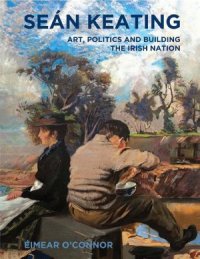Life
| 1889-1977; b. 28 Sept., Limerick, son of Joseph Keating, a book-keeper with a bakery firm, and Anne [née Hannan]; ed. St. Munchin’s College, and Limerick Municipal School of Art; awarded schol. to Dublin Metropolitan School of Art [var. Royal College of Art, Dublin; now NCAD]; acted as studio asst. in London on invitation from William Orpen [q.v.] in London, 1914-16 - previously his teacher at the DMSA; spent 4 years on Aran; moved from Dublin city to a house of own design at Ballyboden (Rathfarnham, Co. Dublin); RHA, 1923, instrumental in rejection of rejection of Roualt’s Christ and the Soldiers by Dublin Corporation, 1942; Pres. of RHA, 1949-62; showed every year for 61 yrs after 1914; taught at National College of Art [NCAD] for 20 yrs.; exhibited a large canvas at New York World Fair; |
| painted patriotic subjects of which the best known is his Men of the West (1915); also Men of the South, armed for an ambush, and large canvas of the Blessing of the Tricolour (Crawford Gallery, Cork); also Night’s Candles Are Burnt Out (1928-29), an allegory of conflict between church, business, revolution and traditional values; MRHA; Keating resisted the publication of the Scandavian-produced Design in Ireland (1961) which was deeply critical of Irish design-sense, including stamps; |
| his cover-ill. for Synge’s Playboy of the Western World, commissioned by Allen & Unwin in 1927, was later used the Synge Centenary stamp issued on 24 March 2009, the original being auctioned at Whyte’s in Dublin in May 2011 (estimated at €15-40K ). BREF DIB DIH |
|
[ top ]
Criticism
Éimear O’Connor, Sean Keating: In Focus (Associated Editions 2008), 64pp. [catalogue]; Éimear O’Connor, Sean Keating: Art, Politics and Building the Irish Nation (Dublin: IAP 2013).
 |
Launched 16 May 2013 |
[ top ]
Notes
Anti-Modernist: Keating was a fine draughtsman who disliked modern trends; Keating was the main figure in the resistance to modernism in Ireland which occasioned the foundation of the Living Art Exhibition; at the Municipal School of Art [later the National College of Art, and finally National College of Art and Design], where he used to ‘take over’ students work in a way now disapproved of.
Irish design? See remarks by Fintan O’Toole in “Culture Shock” [column], in The Irish Times (18 June 2010), Weekend Sect., on the Design in Ireland report issued by a commissioned team of Scandinavian designers by William Walsh of Coras Trachtala [Export Board] in 1961, quoting Gunnar Petersen (Royal Academy of Copenhagen) as the critic of the stamps who wrote of the sixpenny issue featuring the Sword of Light [an claideamh soluis] that the motif was “so timid and transparent that it is killed by the pedantic and boringly executed ornament next to it” - the latter being decorative marginalia from the Book of Kells. His further remarks including such phrases as “childish and insignificant asymmetric placing of elements in the background”; “deplorable layout”; “completely unnecessary noisy background”. On a 1916 commemorative stamp, he wrote of an idealised Irish Volunteer that “[t]the way in which the building [...] bites him in the stomach seems vulgar to those not prepared to accept the strangeness and dishonesty of some of the lower branches of advertising design.” O’Toole records that Sean Keating suggested that the report should not be published at all, but only made available to specialists who requested it, and adds that “the Scandinavians did the country an enormous service with their bluntness. The Kilkenny Design Centre was established in 1963 with assistance from Louis le Brocquy [q.v.] and others.
Municipal Gallery, Dublin, holds Sean Keating, “A Man of the West”, 1916; see in Brian O’Doherty, The Irish Imagination 1959-1971 (1971).
Night’s Candles Are Burnt Out (1928-29), owned by the Oldham Art Gallery, Lancashire, is on loan to the ESB (see Rosc Exhibition Catalogue);
a print of the painting also appears in Kennedy & Gillespie, Ireland, Art into History (Dublin: Town House 1994).
Seán Treacy: Keating’s oil portrait of the IRA Commandant is printed in de Burca, The Soldier’s Song: The Story of Peadar Kearney (Dublin 1957), p.160.
Synge’s Playboy: Allen & Unwin commissioned 10 illustrations of its edition of Synge’s Playboy of the Western World in 1927. The cover illustration, showing Christing raising his loy to his father (modelled by Keating himself) was used for the Synge Centenary stamp in March 2009. The original was auctioned at Whyte’s in Dublin in May 2011 for an estimated 15-40K euro (The Irish Times, 21 May 2011, p.21 [“Fine Arts”]. Note: The Irish Times also reports that one of the series involves an image of Keating as Mahon nude - but this is surely “The Well of the Saints” in Keating’s oil - presumably commissioned also. I.e., the Unwin series was for the complete plays and not solely for The Playboy.
Sale price: “Irish Free State Bacon” (1928), by Sean Keating, an original oil painting commissioned by the British Empire Marketing Board to promote Irish food in Britain,
was offered with an estimate of €15-20,000 in Whyte’s Exceptional Irish Art Sale, 28 Nov. 2011, at RDS, Clyde Halls, Anglesea Rd., Dublin (The Irish Times, 26 Nov. 2011.)
[ top ]